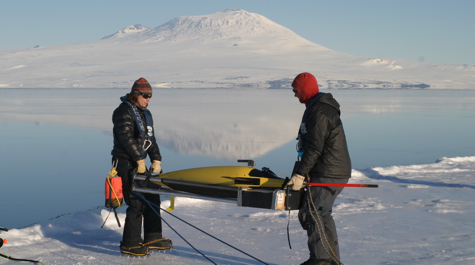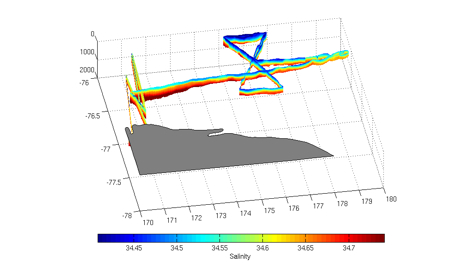Smith team glides into polar research
Underwater glider sets two Antarctic firsts
Researcher Walker Smith of the Virginia Institute of Marine Science has been conducting shipboard studies of biological productivity in Antarctica’s Ross Sea for the last three decades. This year he’s letting underwater robots do some of the work.
Smith and graduate student Xiao Liu are using a two-year grant from the National Science Foundation to deploy and test a free-swimming underwater glider in the frigid waters of the Ross Sea near the U.S. McMurdo Research Station. The grant also funds efforts by fellow VIMS professor Marjorie Friedrichs to use glider data to help improve computer models of the Ross Sea’s physics and biology.
Smith deployed the team’s glider—SG503, also know as the Ice Dragon—for its first mission on November 29, 2010. He and colleagues, including investigators from Old Dominion University, launched the 114-pound vehicle through a whale breathing-hole, and then directed it into the open waters of the “polynya” that forms each austral summer when seasonal sea-ice melts from the Ross Sea.
The launch, at a latitude of 77°S, is the most southerly glider deployment ever. A short (and unintentional) jog off course also made it the first-ever glider to successfully dive beneath the Ross Ice Shelf.
 The glider has now—as of January 19, 2011—completed 783
dives to depths as great as 700 meters (2,330 feet), traveling a total of 1,402
kilometers (871 miles). It is scheduled to continue yo-yoing back and forth across
the Ross Sea polynya until the researchers retrieve it in early February.
The glider has now—as of January 19, 2011—completed 783
dives to depths as great as 700 meters (2,330 feet), traveling a total of 1,402
kilometers (871 miles). It is scheduled to continue yo-yoing back and forth across
the Ross Sea polynya until the researchers retrieve it in early February.
Each of the glider’s dives lasts about 120 minutes, during which sensors on its fiberglass hull measure water temperature, salinity, levels of dissolved oxygen, and chlorophyll concentrations (the latter a measure of photosynthesis and phytoplankton abundance). At the end of each dive, the glider flips its tail into the air so that its antenna can send the collected data to researchers and receive guidance for its next dive. Data is transmitted via the Iridium satellite network.
The potential of gliders
Lacking a motor or propeller, gliders zigzag up and down through the water using a set of fins to translate changes in buoyancy into lateral motion. Their top speed is about one-half mile per hour. A small battery powers the buoyancy changes by forcing mineral oil in and out of an inflatable bladder. Moving the battery fore or aft within the hull shifts the center of gravity to control pitch, rotating it from side to side controls roll.
Smith says that gliders bring several potential benefits to ocean research. For one, because they’re propelled by buoyancy changes rather than an energy-hungry motor, they can remain in the water for months at a time before needing a recharge (the current world record is a 4,500-mile transatlantic crossing that lasted 221 days, using the equivalent power of just 3 Christmas tree lights). Motor-driven underwater robots are limited to missions of a few days at most.
A glider’s small size and simplicity (with only a few moving parts) also makes it relatively inexpensive to own and operate, especially compared to the costs of ship-based ocean research. Smith’s glider—developed at the Applied Physics Laboratory at the University of Washington and now sold commercially by iRobot, Inc. (maker of the Roomba© vacuum cleaning robot)—cost $150,000. A single ship-day, including costs for fuel and crew, can run up to $60,000.
Dr. Mark Patterson, head of the Autonomous Systems Laboratory at VIMS and developer of the Fetch autonomous underwater vehicle (AUV), notes that gliders and other AUVs hold great promise for solving one of the oldest problems in oceanography: the fact that “the ocean changes faster than we have the ability to observe.”
“Traditional ship-based studies can only provide snapshots of the constantly changing ocean ecosystem,” says Patterson. He says “that’s like trying to figure out what’s going on in a TV series like ‘Lost’ by watching just one or two episodes per year.” By sampling the ocean almost continually for months at a time, gliders allow researchers to better understand and model short-term physical changes and how they influence ocean biology.
Gliders in the Ross Sea
Previous studies by Smith and other polar researchers suggest that short-term physical variations—changes in sunlight, wind speed and direction, and current patterns—play a key role in controlling the magnitude, timing, and duration of phytoplankton blooms in the Ross Sea. These blooms sustain the Antarctic food web, from krill up to fish, seabirds, and marine mammals.
But a comprehensive understanding of how these short-term changes impact the polar ecosystem has so far remained elusive. That’s where gliders come in.
“Our glider will help detail the physical and biological oceanography of the southern Ross Sea by sampling the region continuously through the growing season,” says Smith. “Given its ability to repeatedly sample specific areas, it holds great promise for resolving short-term and seasonal trends.”
Mission & Modeling
During the team’s upcoming retrieval mission, which sets sail on January 19, Smith and Liu will first spend several weeks comparing their shipboard measurements of water temperature, salinity, dissolved oxygen, and chlorophyll to those recorded by the glider. That’s to ensure that the glider’s sensors are still accurately calibrated after more than two months in the water. The retrieval team will be aboard the research vessel Nathaniel B. Palmer.
Friedrichs will feed the glider’s high-resolution data into computer models of physical and biological processes in the Ross Sea, with the long-term goal of making model predictions more accurate.
“Current models are difficult to evaluate using data that are appropriate on the same space and time scales,” says Friedrichs. “Data collected by gliders over shorter time-scales are what we need to drive the next generation of circulation and ecosystem models. Improving the modeling and predictability of dynamic systems like the Ross Sea is our ultimate goal.”




